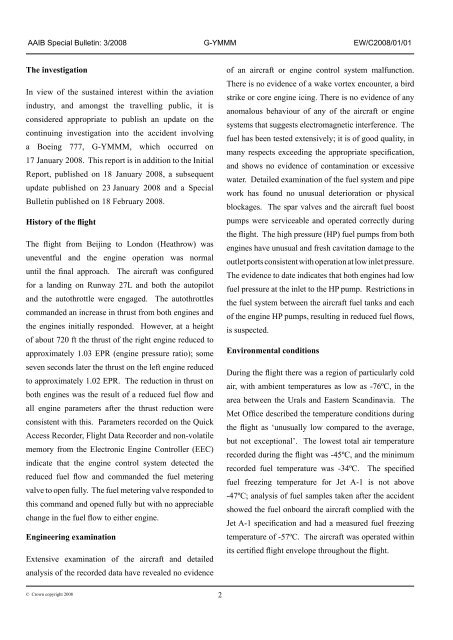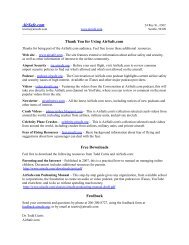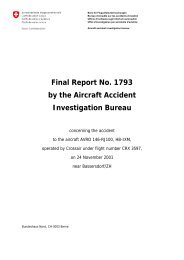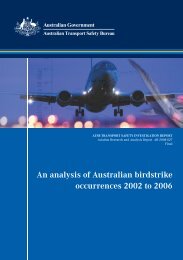AAIB Investigation Updates (PDF) - Airline Safety and Security ...
AAIB Investigation Updates (PDF) - Airline Safety and Security ...
AAIB Investigation Updates (PDF) - Airline Safety and Security ...
Create successful ePaper yourself
Turn your PDF publications into a flip-book with our unique Google optimized e-Paper software.
<strong>AAIB</strong> Special Bulletin: 3/2008 G-YMMM EW/C2008/01/01<br />
The investigation<br />
In view of the sustained interest within the aviation<br />
industry, <strong>and</strong> amongst the travelling public, it is<br />
considered appropriate to publish an update on the<br />
continuing investigation into the accident involving<br />
a Boeing 777, G-YMMM, which occurred on<br />
17 January 2008. This report is in addition to the Initial<br />
Report, published on 18 January 2008, a subsequent<br />
update published on 23 January 2008 <strong>and</strong> a Special<br />
Bulletin published on 18 February 2008.<br />
History of the flight<br />
The flight from Beijing to London (Heathrow) was<br />
uneventful <strong>and</strong> the engine operation was normal<br />
until the final approach. The aircraft was configured<br />
for a l<strong>and</strong>ing on Runway 27L <strong>and</strong> both the autopilot<br />
<strong>and</strong> the autothrottle were engaged. The autothrottles<br />
comm<strong>and</strong>ed an increase in thrust from both engines <strong>and</strong><br />
the engines initially responded. However, at a height<br />
of about 720 ft the thrust of the right engine reduced to<br />
approximately 1.03 EPR (engine pressure ratio); some<br />
seven seconds later the thrust on the left engine reduced<br />
to approximately 1.02 EPR. The reduction in thrust on<br />
both engines was the result of a reduced fuel flow <strong>and</strong><br />
all engine parameters after the thrust reduction were<br />
consistent with this. Parameters recorded on the Quick<br />
Access Recorder, Flight Data Recorder <strong>and</strong> non‐volatile<br />
memory from the Electronic Engine Controller (EEC)<br />
indicate that the engine control system detected the<br />
reduced fuel flow <strong>and</strong> comm<strong>and</strong>ed the fuel metering<br />
valve to open fully. The fuel metering valve responded to<br />
this comm<strong>and</strong> <strong>and</strong> opened fully but with no appreciable<br />
change in the fuel flow to either engine.<br />
Engineering examination<br />
Extensive examination of the aircraft <strong>and</strong> detailed<br />
analysis of the recorded data have revealed no evidence<br />
of an aircraft or engine control system malfunction.<br />
There is no evidence of a wake vortex encounter, a bird<br />
strike or core engine icing. There is no evidence of any<br />
anomalous behaviour of any of the aircraft or engine<br />
systems that suggests electromagnetic interference. The<br />
fuel has been tested extensively; it is of good quality, in<br />
many respects exceeding the appropriate specification,<br />
<strong>and</strong> shows no evidence of contamination or excessive<br />
water. Detailed examination of the fuel system <strong>and</strong> pipe<br />
work has found no unusual deterioration or physical<br />
blockages. The spar valves <strong>and</strong> the aircraft fuel boost<br />
pumps were serviceable <strong>and</strong> operated correctly during<br />
the flight. The high pressure (HP) fuel pumps from both<br />
engines have unusual <strong>and</strong> fresh cavitation damage to the<br />
outlet ports consistent with operation at low inlet pressure.<br />
The evidence to date indicates that both engines had low<br />
fuel pressure at the inlet to the HP pump. Restrictions in<br />
the fuel system between the aircraft fuel tanks <strong>and</strong> each<br />
of the engine HP pumps, resulting in reduced fuel flows,<br />
is suspected.<br />
Environmental conditions<br />
During the flight there was a region of particularly cold<br />
air, with ambient temperatures as low as -76ºC, in the<br />
area between the Urals <strong>and</strong> Eastern Sc<strong>and</strong>inavia. The<br />
Met Office described the temperature conditions during<br />
the flight as ‘unusually low compared to the average,<br />
but not exceptional’. The lowest total air temperature<br />
recorded during the flight was ‐45ºC, <strong>and</strong> the minimum<br />
recorded fuel temperature was -34ºC. The specified<br />
fuel freezing temperature for Jet A-1 is not above<br />
‐47ºC; analysis of fuel samples taken after the accident<br />
showed the fuel onboard the aircraft complied with the<br />
Jet A-1 specification <strong>and</strong> had a measured fuel freezing<br />
temperature of -57ºC. The aircraft was operated within<br />
its certified flight envelope throughout the flight.<br />
© Crown copyright 2008











